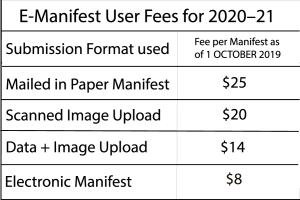TO MANAGE THE TRANSITION TO REPORTING E-MANIFEST
November 7, 2019

A New Challenge
The EPA’s Uniform Hazardous Waste Manifest initiative is one of the most important set of requirements to emerge in the waste industry in some time. Beginning in July 2018, the hazardous waste e-manifest system has been available to generators, transporters, and receiving facilities for use in creating and submitting manifests electronically. Perhaps unsurprisingly for an ambitious technology initiative, the rollout has not been entirely smooth. However, while there have been some glitches in the system and it still does not do all the things it was advertised to perform, the basic program is expected to require all handlers of hazardous waste (i.e. generators, transporters, and treatment facilities) to use the EPA’s electronic portal by in the next few years. Treatment, Storage, and Disposal Facilities (TSDFs) are expected to transition fully by June 2021 with full integration by generators slated for June 2023.
Slow Adoption
The emergence of e-manifest does not relieve transporters of the Federal Department of Transportation (DOT) requirements. For example, paper copies of all Hazardous Waste Manifests ( form 8700-22 ) are still required to accompany the transporter vehicle when shipping hazardous waste over the road. Additionally, the DOT will continue to require transporters of hazardous materials to complete triennial training per the requirements of 49 CFR 172.704.
Because all parties still have a choice to submit manifests by mailing paper copies until the 2021 and 2023 deadlines, many generators and TSDFs have been reluctant to move quickly to the e-manifest system. It’s easy to understand why: cost. In fact, the EPA recently implemented a price increase to handle manifests using the new electronic system. In some cases, the new fee schedule can mean an increase of over 20% from last year’s costs.

Another unforeseen difficulty has emerged around a variety of forms, permits, and local requirements that characterize various facilities. Traditionally TSDFs design data handling and operational software to suit their own facility requirements. Permits for waste handling can vary dramatically from state to state. This means that registering on the EPA site and using the system is only the start. Unless both the transporter and the TSDF are using the e-manifest system, paper-based manifest record-keeping programs are still necessary.
The result of these complexities is that widespread adoption of the uniform hazardous waste manifest has been slow. One recent comment from the EPA indicated that current e-manifest volume trails estimates by more than a million manifests!
WASTELINQ Can Help
Despite the hesitancy among hazardous waste community members to use the e-manifest system, the deadlines for integration are not going away. WASTELINQ’s web-based platform is designed to accommodate e-manifest submission. In fact, future updates to WASTELINQ’s comprehensive waste management and strategy platform will include options for lowering the costs of complying with e-manifest requirements. WASTELINQ’s waste management software and support are designed to manage waste in all 50 states plus the District of Columbia. For more information about WASTELINQ, visit www.WASTELINQ.com, or call us at 713-859-8252.